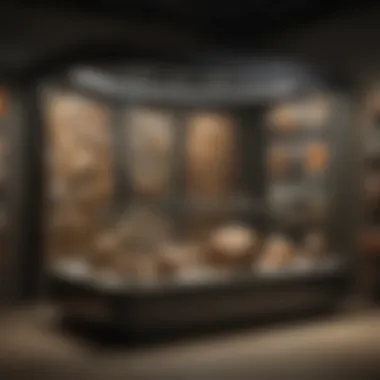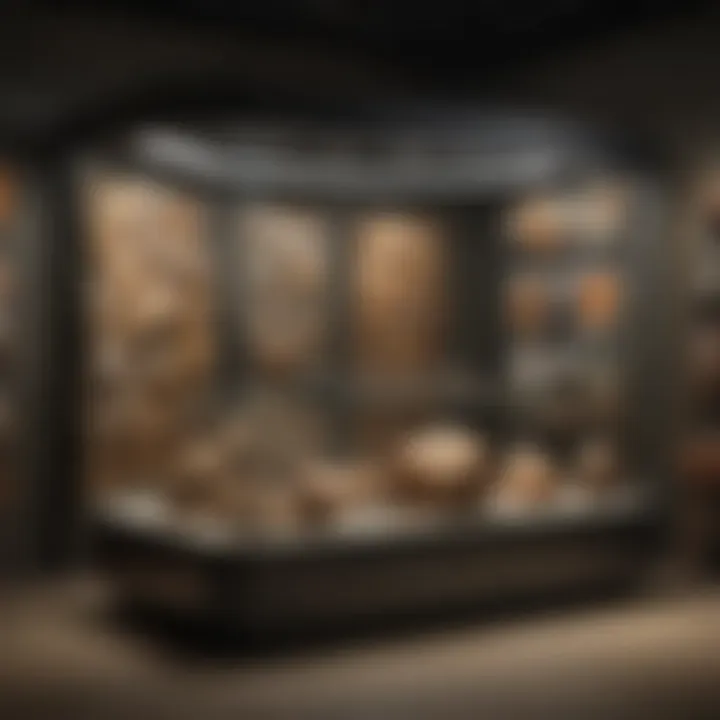Museum Display Stands: Balancing Function and Design


Intro
Museum display stands are more than just functional furniture; they are pivotal in shaping how we experience art and history. The careful selection and design of these stands can greatly enhance the viewer's appreciation of artifacts while simultaneously aiding their preservation. In recent years, the spotlight has shone on how aesthetics intertwine with functionality to create an engaging visitor experience. Understanding these dynamics is crucial for curators, collectors, and enthusiasts alike.
With an ever-growing collection of exhibits, museums face the challenge of not merely displaying objects but creating narratives around them. The choice of materials, design, and even positioning of display stands influence not only the conservation of artifacts but also the emotional and intellectual engagement of visitors. Thus, the role of display stands in the museum ecosystem is far from trivial.
In the paragraphs that follow, we will break down the key themes surrounding museum display stands, exploring how functionality and aesthetics coexist and impact the visitor experience. Through this exploration, we aim to provide insights that resonate with rock and fossil collectors, shedding light on the specific needs of these unique artifacts, as well.
Featured Collectible of the Month
Overview
This month's featured collectible is the stunning Blue Lace Agate, a type of banded chalcedony. The delicate light blue hues and intricate patterns make it not only a collector’s gem but also a fascinating specimen for display. Its formation in volcanic rocks millions of years ago tells a story that bridges the earth's past with contemporary aesthetics. Specimens like these deserve more than just a place in a cabinet; they deserve a well-considered stand that emphasizes their natural beauty while also ensuring their safety.
Historical Significance
Blue Lace Agate has a rich historical background, with origins tracing back to Africa, specifically in Botswana. Traditionally, cultures have attributed this mineral with healing properties, making it a sought-after stone in both jewelry and holistic practices. Displaying such a collectible in a museum enhances not just its physical beauty but also connects visitors to the ancient beliefs and geology that shape our understanding of this captivating mineral.
"The beauty of each displayed piece resonates not only with its physical form but also with the myriad stories it has spun over centuries."
Identification Techniques
Visual Characteristics
When it comes to identifying unique collectible pieces like Blue Lace Agate, certain visual clues can be quite telling:
- Color: Look for the soft blue shades, often accented with white or gray banding.
- Patterning: Intricate patterns emerge as you observe the specimen closely, indicating its banded nature.
- Transparency: While some specimens may be cloudy, the best pieces have a translucent quality that enhances their appeal.
Resources for Identification
Accurate identification of museum display pieces can require substantial knowledge and resources. Here are some valuable tools:
- Books: Guides on mineral identification can be crucial for collectors.
- Online Forums: Websites like reddit.com host discussions where enthusiasts share insights and experiences.
- Museums and Universities: Engaging with local institutions can provide access to experts and specialized resources.
Understanding Museum Display Stands
When stepping into a museum, many of us are immediately struck by the artifacts on display. But it's often the display stands that truly shape the experience. Understanding museum display stands goes beyond knowing merely what they are; it delves into their essential role in both functionality and aesthetics.
These stands act as the silent guardians of artifacts, helping to preserve their integrity while enhancing the visitor’s connection to the exhibit. By learning about the intricate details of display stands, collectors and enthusiasts can grasp how these elements contribute to the storytelling of artifacts.
Definition and Purpose
At their core, display stands serve multiple purposes in the world of museums. First and foremost, they are designed to present artifacts in a way that maximizes visibility and appreciation. Good design is like a well-tuned orchestra; it harmonizes every piece for a greater effect. Display stands can elevate objects, allowing onlookers to view them from unique perspectives, while also ensuring that items are appropriately sized relative to the space they occupy.
They play a pivotal role in ensuring that the artifacts remain undisturbed. For instance, certain display stands include protective features that guard against dust or accidental touch. Moreover, stands can guide visitor movement, directing attention to key pieces and enhancing the narrative the curator wishes to present. By doing so, they help to foster a dialogue between the artifact and the audience, leading to deeper engagement.
Historical Context
The story of display stands isn't just about functionality; it has roots in artistic expression. Historically, display stands have evolved alongside the artifacts they showcase. In ancient civilizations, objects were often mounted on plinths made of stone or wood, reflecting the significance bestowed on these items. For example, Egyptian tombs featured intricately carved bases that not only served a practical purpose but also enhanced the sacredness of their contents.
Moving into the Renaissance, the approach shifted as artisans began incorporating more decorative elements into the design of display stands. This was a period characterized by the blending of art and functionality. The stands became an extension of the artwork they displayed, often adorned with motifs that reflected the other pieces in the environment. As museums began to develop in the 18th and 19th centuries, a more standardized approach emerged, focused on balancing safety and aesthetics within public spaces.
In modern times, the trend has seen a shift towards more innovative materials and designs, reflecting contemporary tastes and the use of technology in presentation. The evolution of display stands illustrates how society’s values and artistic sensibilities influence what we consider proper ways to showcase our history and culture.
"Art must be an integral part of the experience; hence, the stand is not merely functional but a part of the narrative."
Through understanding the context and purpose of display stands, rock and fossil collectors can appreciate how their choices in presentation can either enhance or detract from the artifacts they cherish.
Types of Display Stands
When it comes to showcasing artifacts in a museum, the types of display stands play a vital role. Different stands serve various purposes, each with unique benefits that can enhance the presentation of objects. Moreover, they contribute significantly to the overall aesthetic and functional quality of a display. This discussion delves into the four primary categories of display stands: pedestal stands, wall-mounted displays, tabletop stands, and showcases or cabinets.
Pedestal Stands
Pedestal stands are synonymous with elegance and prominence. These stands are often used for larger artifacts or those that deserve a spotlight. They raise the exhibited object to eye level, creating an impactful viewing experience. This encourages visitors to engage with the display from various angles, thus leading to deeper appreciation. For rock and fossil collectors, pedestal stands not only ensure the object's visibility but also help prevent distracting background clutter. Additionally, these stands can be designed with various materials—like polished wood or sleek metal—to match the museum’s overall aesthetic.
One noteworthy aspect is the stability these stands provide. A well-balanced pedestal stand assures that exhibits remain safe, reducing the risk of accidents.


Wall-Mounted Displays
Wall-mounted displays are a space-savvy option, ideal for showcasing smaller items or collections that need to be viewed closely. By utilizing vertical space, these displays can keep the floor area open, maximizing the movement and flow within a gallery. Incorporating various heights and alignments can add an element of dynamism, encouraging viewers to look up and explore. For collections like minerals or framed fossils, wall-mounted displays draw visitors' attention straight to the items of interest while also providing information panels nearby.
A point to consider is the accessibility of these setups for all heights and physical capabilities. Thoughtful placement can maintain inclusivity, ensuring everyone gets to appreciate the items on display.
Tabletop Stands
Tabletop stands occupy a unique niche; they are primarily used for temporary exhibitions or small collections. These stands are versatile and can be easily moved or rearranged, making them perfect for dynamic displays that require frequent updates. They can range in design from rustic wooden frames to more contemporary glass options. Such stands also serve the dual purpose of showing off the collection while maintaining an inviting atmosphere, ideal for intimate settings or educational workshops.
For rock and fossil enthusiasts, tabletop stands can also be functional; they allow for hands-on interaction in certain contexts. This tactile experience can significantly enrich understanding and enjoyment of the pieces displayed.
Showcases and Cabinets
Showcases and cabinets represent a more traditional approach to displaying artifacts in museum settings. These enclosure types protect valuable items while allowing visitors to admire them up close. They're typically made of glass or acrylic, ensuring that artifacts are visible but safeguarded from environmental factors, such as dust or direct sunlight. They can come in many styles—freestanding units or built into the walls, depending on the design and layout of the museum.
For collectors, showcases offer the chance to group related pieces together, telling a more comprehensive story or promoting a specific theme. Furthermore, they provide an additional layer of security, particularly crucial for rare items or high-value collections.
Showcases extend beyond visibility; they encapsulate an experience for the visitor, inviting curiosity while safeguarding the displayed treasures.
The various types of display stands each bring something distinct to the table in a museum context. From the grandeur of pedestal stands to the practicality of tabletop stands, every choice contributes deeply to how artifacts are appreciated and understood, especially for those with a keen interest in rocks and fossils.
Materials Used in Display Stands
The materials chosen for museum display stands are crucial to both the aesthetic appeal and the functional integrity of an exhibit. Selecting the right material not only impacts how objects are perceived but also ensures their protection. As we delve into the categories of materials, we will uncover their unique characteristics and the thoughtful considerations needed to enhance the overall visitor experience while preserving artifacts.
Wooden Stands
Wood has been a staple in display stand construction for centuries. Its versatility and natural beauty make it an ideal choice for many museums. Wooden stands can be crafted in countless styles, from rustic to ornate, fitting a wide range of themes. Additionally, wood is often associated with warmth, enhancing the invitation of an exhibit.
However, maintaining environmental stability is vital. It’s essential to treat the wood to resist pests and decay, and steps should be taken to manage humidity and temperature where they are used. Curators often select hardwood like oak or walnut due to their durability, willing to invest in quality to ensure longevity and security for their prized artifacts.
Metal Displays
Metal displays represent a fusion of strength and elegance. Steel and aluminum are frequently used due to their robust nature and ability to be molded into sleek, modern forms. Metal materials lend a contemporary edge to exhibitions, often complementing modern artifacts seamlessly.
- Benefits of Metal Displays:
- Strength: Capable of supporting heavier artifacts without bending or breaking.
- Sustainability: Recyclable; thus contributes to environmental preservation when sourced responsibly.
Yet, metal can come with its challenges. It often requires careful finishing to avoid corrosion or aesthetic dullness. Additionally, museum spaces must ensure that metal stands do not interfere with environmental controls or trigger rust on sensitive items.
Acrylic and Glass Options
Acrylic and glass are favored for their transparency, giving visitors an unobstructed view of the displayed items. They provide an air of sophistication and modernity that resonates with contemporary aesthetic sensibilities. Exhibitions featuring delicate items—like jewelry or scientific specimens—often utilize these materials for their protective qualities while enhancing visibility.
A few key points when considering acrylic and glass:
- Clarity: Ensures maximum visibility and minimal reflection, providing viewers with clear access to artifacts.
- Protection from Dust: They act as barriers to environmental elements while allowing light to pass through.
- Weight Considerations: Although they can be heavy, their light-weight versions help ease display layout.
Nonetheless, care must be taken with glass, as it's prone to shattering, and acrylic can scratch over time if not properly cleaned.
Sustainable Materials
With increasing awareness around sustainability, the shift toward eco-friendly materials is gaining momentum in museum exhibit design. Museums are beginning to prioritize materials that not only support environmental stewardship but also resonate with today’s audience values. Some sustainable options include:
- Bamboo: Rapidly renewable and sturdy; its natural look can enhance many themes.
- Recycled Composites: Made from post-consumer materials that reduce waste and provide unique textures.
- Natural Fiber Options: Such as hemp or jute, providing durability and eco-friendliness in a lighter format.
Utilizing these materials demonstrates a museum’s commitment to sustainability while appealing to a socially-conscious audience.
"In a world that increasingly values environmental consciousness, choosing sustainable materials is not just an option but a responsibility for museums aiming to leave a positive legacy."
Choosing the right materials for display stands is not just about aesthetics but also about the story crafters want to tell through each exhibit. As we've explored, these decisions impact preservation, visitor engagement, and the very essence of the museum experience. Whether through the warmth of wood, the strength of metal, the clarity of acrylic, or the ethics of sustainability, each material plays a vital role in how artifacts are presented and appreciated in the broader storyline of history.
Design Considerations
When creating displays for museums, the importance of design considerations cannot be understated. The way display stands are designed not only affects the visual appeal of the museum but also directly impacts the visitor's experience, interaction with artifacts, and even the preservation of the items on display. Each aspect of design needs careful thought to strike a balance between aesthetics, functionality, and safety.
Aesthetic Coherence


Aesthetic coherence refers to how well the display integrates with the overall theme and style of the museum and its exhibits. Visitors often subconsciously judge the value of displayed items based on their presentation. For instance, a beautifully crafted, wooden pedestal displaying an indigenous artifact can evoke feelings of respect and admiration, enhancing the item's cultural value in the eyes of the observer.
- Visual Harmony: One must consider colors, textures, and shapes. A display that aligns with the artifacts—like a dark wood stand for a vintage fossil—creates a narrative that resonates.
- Brand Identity: Museums need to establish a consistent identity across exhibits. A uniform design language can make the experience smoother and more memorable for visitors.
"The first time you step into a museum, you shouldn't just see artifacts. You should feel them; and part of that impact is how they're displayed."
In essence, aesthetic coherence isn’t merely about looks—it's about creating an immersive experience that captivates the audience from the moment they walk through the door.
Functionality and Accessibility
Functionality and accessibility come hand-in-hand when discussing display stands. The primary goal of a display stand isn't just to look good; it must effectively showcase artifacts while ensuring they are accessible to all visitors, including those with mobility issues. Practical considerations play a crucial role:
- Height and Visibility: A display stand must allow all visitors to see items comfortably. Standards generally recommend that key items should be positioned at eye level to engage as many people as possible.
- Clear Navigation: Visitors should not have to maneuver through complex layouts. Stands should promote a seamless flow, guiding guests through the exhibit without crowding or confusion.
- Interactivity: Encouraging visitor interaction—whether through touch screens or clearly placed information cards—can create a more educational experience.
Safety and Stability
Lastly, safety and stability are critical for display stands. Artifacts can be valuable and fragile; if a display isn’t sturdy, it might not withstand the occasional jostle from curious visitors. The design must prioritize:
- Material Strength: The chosen materials should provide adequate support. Metal frames or reinforced glass can make all the difference in avoiding accidents.
- Structural Design: Consideration must be given to the distribution of weight. A well-designed display won’t tip over easily, even if visitors lean in for a closer look.
- Preventing Theft and Damage: Security features, such as locks in display cases and stable bases, help protect the artifacts from theft or accidental harm.
By paying attention to design considerations—from the aesthetics to functionality and safety—museums can create a compelling environment that fosters learning and appreciation for the artifacts on display.
Role of Display Stands in Artifact Preservation
The function of display stands extends beyond mere aesthetics and organization; they play a crucial role in the preservation of artifacts. By selecting appropriate display stands, museums not only enhance the visual appeal of their exhibits but also protect valuable items from potential threats. Understanding this duality is especially relevant for curators, collectors, and enthusiasts alike, particularly those with an interest in sustainable practices and the longevity of objects.
Protection from Environmental Factors
Artifacts face various environmental challenges such as humidity, temperature fluctuations, and exposure to light. Display stands can significantly mitigate these factors. For instance, enclosed displays, like vitrines made of glass, can create a controlled atmosphere. These stands often come with features like coasted glass that rejects UV rays, reducing the risk of fading or deterioration. This becomes highly significant for organic materials, like wood or textiles, which are particularly susceptible to environmental changes.
Another important factor is the material of the display stand itself. Wooden stands must be treated to prevent any chemical interactions that could harm artifacts. Meanwhile, acrylic materials, while sturdy, can also trap heat, so ventilation in their design becomes vital.
"The best display stands are those invisibly working behind the scenes, ensuring the artifacts remain pristine while allowing them to shine before the eyes of visitors."
By actively combating issues like excessive moisture and light exposure, display stands provide a sanctuary for precious items, preserving their integrity for future generations.
Minimizing Physical Damage
Physical damage to artifacts can arise from various sources—improper handling, accidental impacts, or even vibrations from nearby foot traffic. The right display stands can be designed to minimize these risks effectively. For instance, using anti-tip features in pedestal stands can prevent them from being easily knocked over. Additionally, safety barriers can help maintain a safe distance between visitors and delicate items, further preventing incidental contact.
Moreover, a well-designed display stand should consider the weight and balance of the item being displayed. A top-heavy statue, when hastily placed on an inadequately constructed stand, can spell disaster. Thus, selecting stands that correspond to the specific needs of the artifacts is paramount.
Incorporating padding where artifacts make contact with the display stand can also act as a cushioning layer, reducing the chance of scratches or material loss. Ultimately, the aim is to create a display that supports and protects, allowing visitors to engage with artifacts without compromising their condition.
In summary, the role of display stands in artifact preservation cannot be understated. They help protect artifacts from environmental and physical threats, ensuring that these treasures of history remain intact and available for future exploration.
Psychology of Display
In the realm of museums, the psychology of display proves to be a keenly important aspect, guiding not only how artifacts are presented but also how visitors engage with the pieces before them. This section peels back the layers of visitor perception, emotion, and interaction, illustrating how display strategies can enhance the overall museum experience. The balance between functionality and aesthetics emerges as a powerful intersection, relevant to cultural institutions aiming to leave a lasting impression on their audiences.
Visitor Engagement
Engaging visitors is, at its core, an art form. The way display stands are designed plays a critical role in capturing attention and sparking curiosity. For instance, consider a rock and fossil exhibit in a natural history museum. A thoughtfully positioned display stand encourages visitors to lean in closer, their faces lit with intrigue as they take in the textures, colors, and shapes of the geological wonders. It’s not just about what stands are made of, but also about how they invite people to interact with the displayed objects.
- Height and Visibility: A pedestal stand placed at eye-level dramatically shifts the visitor's focus, making it easier for them to absorb details. If an exquisite trilobite fossil is showcased on a sleek metallic stand, the contrast against the natural rock draws attention and curiosity.
- Lighting Techniques: Proper lighting is another factor that boosts engagement. Utilizing well-placed spotlights can create a dramatic backdrop, enhancing the visual impact. Shadow and light create emotional nuances and can lead the onlooker's gaze right where you want it.
Moreover, interactivity, such as touch screens or augmented reality setups that allow visitors to engage at a deeper cognitive level, heightens the experience, enticing the audience to linger longer than they might have intended.
"The role of display stands transcends mere support; they turn the mundane into the captivating."
Cognitive Load and Learning
Cognitive load refers to the amount of mental effort being used in the working memory. When dealing with information-rich environments like museums, it's crucial to manage this load, ensuring that it doesn't become overwhelming for the visitor. Well-designed display stands contribute significantly to this by organizing and presenting information in a digestible manner.
- Simplified Information Flow: A visual hierarchy helps visitors process information efficiently. For example, each stand can include concise text or illustrative graphics explaining the geological history of specimens. Instead of long paragraphs, bullet points or icons can facilitate quicker comprehension.
- Thematic Arrangements: By grouping similar rocks or fossils together, visitors can make connections, enhancing learning. Displaying a variety of minerals with shared characteristics encourages comparative thought, allowing for deeper engagement with the material.
Short, impactful descriptions written in a conversational tone uphold visitor interest without weighing them down. Think of crafting your descriptions like a chat with a friend—informative but friendly, inviting, and easy to digest.


By integrating these techniques, museum curators can transform a potentially overwhelming experience—a feast of knowledge—into a pleasing journey of discovery, thereby enhancing both understanding and retention.
In summary, the psychology of display fundamentally shapes how visitors interact with the exhibits. By focusing on engagement through strategically designed display stands and minimizing cognitive load, museums can create environments that not only showcase artifacts but also nurture a passion for learning and exploration among visitors.
Current Trends in Display Stand Design
The landscape of museum display stands is continually evolving, shaped by advances in technology, shifts in aesthetic preferences, and a deepening understanding of visitor experience. In a time when interactivity and sustainability are highly valued, it’s essential to explore these current trends in display stand design. For collectors and curators, knowing these trends helps to create environments that not only showcase artifacts beautifully but also engage and educate visitors.
Innovative Materials and Technologies
Recent years have seen a notable shift towards innovative materials that marry functionality and aesthetics. Traditional materials like wood and glass are being complemented, and sometimes replaced, by options that boast better durability and lighter weights. Carbon fiber and bioplastics are emerging favorites, offering substantial strength without the bulk. These materials not only meet the demands of preservation but also help in creating sleek designs that can enhance the viewing experience.
Additionally, technology is making waves in the design of display stands. Sophisticated lighting solutions, such as LED systems, can be integrated into stands to highlight artifacts without causing damage through excessive heat. Some stands are even equipped with built-in sensors that adjust ambient light based on the time of day, ensuring optimal conditions for both the displayed objects and the visitors.
Moreover, advancements in smart technology allow for real-time interaction with the audience. When a visitor approaches a display, for instance, the stand can trigger a digital screen that provides additional information about the artifact. This blend of physical displays with digital knowledge enhances the storytelling component of exhibitions, making each visit memorable.
"Innovative materials and smart technology in display stand design foster a deeper connection between artifacts and visitors, changing how we experience history and culture."
Interactive Displays
The rise of interactive displays is transforming standard museum visits into immersive journeys. These stands not only serve as holders for artifacts but also as gateways for engagement. Interactive displays can take various forms, such as hands-on installations or digital interactions such as touchscreens that provide extra context or even augmented reality experiences.
Museums are adopting these techniques to cater to diverse learning styles. For example, rock and fossil collectors can benefit immensely from tactile displays that allow them to feel the weight or texture of certain geological materials. Virtual displays that let visitors rotate or zoom into 3D models provide an alternative perspective that traditional displays could never offer.
Furthermore, interactive features can include quizzes or games that challenge visitors’ knowledge about the items on display. This gamification not only entertains but also solidifies learning, making information more memorable.
In summary, as we embrace innovative materials and embrace interactive elements, museum display stands are not merely functional items. They have become integral to the overall experience, helping to bridge the gap between the past and the present, and enhancing the connection between visitors and history, particularly for specialized audiences like rock and fossil collectors.
Challenges in Display Stand Utilization
In the world of museums, where every piece of art or artifact has its own story to tell, the display stand becomes more than just furniture. It is both an enabler and a barrier in the intricate dance between artifact preservation and visitor engagement. The way museum display stands are utilized can significantly affect how effectively artifacts are showcased and interpreted.
Challenges in this realm often stem from two core issues: space limitations and budget constraints. Understanding these challenges is crucial for curators and exhibition designers alike, as they not only influence the practicality of display arrangements but also affect the overall museum experience given to the visitors.
Space Limitations
Space can often feel like a double-edged sword in museum settings. Many institutions are housed in historic buildings with restrictive layouts or smaller galleries that can limit the type and number of display stands that can be practically included.
- Maximization of Space: It is crucial for designers to maximize every square meter. They must think critically about how to utilize walls, corners, and vertical height effectively without compromising the experience or safety of the artifacts.
- Flow of Visitor Traffic: A common pitfall is placing display stands in locations that disrupt visitor flow. When stands are poorly positioned, it can lead to congestion, making it difficult for visitors to engage with exhibits fully.
In light of these challenges, many museums are finding creative solutions such as:
- Using modular display stands that can be reconfigured for different exhibits.
- Incorporating multi-purpose furniture that serves as seating while also displaying small artifacts.
These approaches help invite visitors into learning experiences rather than sacrificing the integrity of the space.
Budget Constraints
Money, or the lack thereof, can be a real sticking point when it comes to museum displays. With funding often spread thin, the challenge escalates as institutions try to strike a balance between high-quality displays and limited budget allocations.
- Quality vs. Cost: Cheaper materials may save money in the short-term, but they might not provide the necessary protection for delicate artifacts or fail to create a visually pleasing experience. On the flipside, premium display stands can significantly enhance the aesthetic appeal but can strain budget allowances.
- Investment in Design: Museums are increasingly recognizing that investing in good display design pays off in the long run. Well-designed stands can elevate the visitor experience and potentially boost ticket sales through greater engagement. However, finding that right balance can be daunting.
Through thoughtful design solutions and innovative material combinations, it is possible to navigate these fiscal challenges.
"Budget constraints lead to creativity, pushing museums to think outside the box, making constraints a powerful catalyst for innovative design."
Navigating the challenges in display stand utilization is pivotal for museums striving to offer rich experiences while preserving their artifacts’ stories. Each decision in terms of space and budgeting reflects on how effectively a museum can communicate to its audience, particularly in a world where the display can make or break an exhibit's impact.
Case Studies of Successful Displays
Understanding how museum display stands have been employed effectively can shed light on their role in facilitating both functionality and aesthetic appeal. This section explores notable case studies that highlight diverse approaches to display stands in iconic museums and special exhibitions. By analyzing these instances, it’s possible to glean lessons on how to enhance artifact presentation while maximizing visitor engagement.
Iconic Museums and Their Approaches
Museums across the globe briliantly utilize display stands to create captivating environments for their collections. For example, the British Museum in London integrates minimalist, yet striking, pedestal stands for its ancient artifacts. These stands are designed to keep the focus firmly on the items themselves without overwhelming the visitor with extraneous visual elements. Each piece is strategically illuminated, allowing the fine details to shine while remaining safe from wear and tear. The use of glass toppers further ensures that even the most delicate items are protected while still being visible up close.
"Museum displays are like fine wines; they need the right vessel to truly shine."
Similarly, the Natural History Museum holds an extensive collection of fossils, and its use of wall-mounted displays transforms the narrative of paleontology into an immersive experience. By arranging the fossils in a timeline, visitors can walk through geological periods, piecing together the story of life on Earth. This approach not only highlights the artifacts but also engages the mind of the visitors, allowing them to explore a conceptual journey through time.
Exhibitions that Emphasized Display Design
Several temporary exhibitions have placed significant importance on innovative display designs, making them memorable and impactful. The Van Gogh Museum in Amsterdam once ran an exhibition focused on Van Gogh's relationship wih color. The curatorial team designed dynamic, interactive stands that allowed attendees to engage with the artist's palette and techniques. Each display facilitated hands-on learning, demonstrating mixing colors in a way that mimicked Van Gogh's process. This kind of setup not only draws people in but enriches their comprehension of art.
Another compelling example is seen in The American Museum of Natural History in New York. Their recent exhibition on Dinosaur Fossils skillfully integrated augmented reality with traditional display methods. Stands were designed with digital interfaces, enabling visitors to view 3D representations of the organisms as they would have appeared in their habitats. This melding of tangible and digital experiences proved to dramatically heighten visitor engagement, sparking curiosity while educating about marine and terrestrial life long gone.



